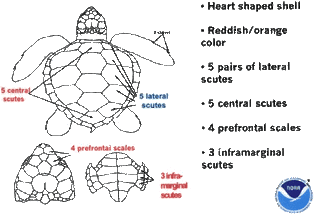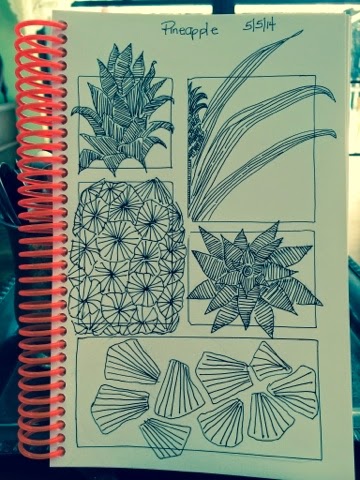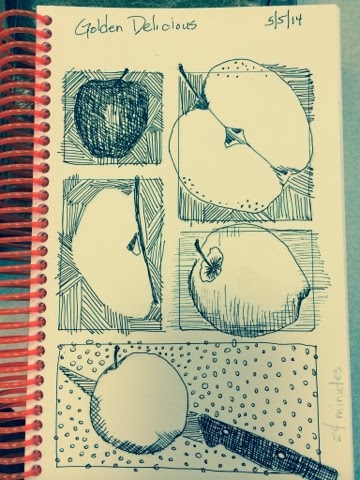|
I'm excited to start another course this week through University of Florida's Distance Learning Program. I will be taking Curriculum in Teaching Art with Professor Craig Roland. This course should help me develop a better understanding of "various theories and approaches to planning art curricula". I look forward to improving as an art educator and implementing new ideas in the art program at FBCS.
A few weeks ago I visited the Rocks Beach on Hutchinson Island. I noticed that the public restroom really needed a paint job. As I walked along the beach I began to see numerous sea turtle nests marked with stakes and colored ribbons. I thought, wouldn't it be nice to paint loggerhead sea turtles on the exterior of the restroom. So, I have been researching and creating a sketchbook on loggerhead turtles for the class I am taking through University of Florida. And who knows -- maybe there will be loggerheads painted on that restroom. Here is what I have put together: Loggerhead turtles are named after their exceptionally large heads. The scientific name is Caretta caret. Along with strong jaws they have a horny beak that is thicker than most sea turtles. Surprisingly, they have no teeth. Loggerheads can weigh anywhere between 155 to 375 pounds, although large specimens have been found weighing as much as 1000 pounds (Loggerhead Sea Turtle, 2014). The loggerhead’s skin is cream to yellow and brown. Their smooth, reddish to orange brown carapace (shell) measures 2.5 to 3.5 feet in length. As the turtle ages their shell can become covered with algae and barnicles giving it a green to gray color (Georgia Aquarium Animal Fact Sheet, n.d.). It is heart shaped, bony, and has large non-overlapping rough scales. The carapace is divided into five pairs of lateral scutes (sections), five central scutes, four prefrontal scales, and three inframarginal scutes (Figure 1: Loggerhead Sea Turtles, 2014). The front flippers are short, thick, and have two claws. The back flippers have two to three claws. These paddle-like flippers help them swim at speeds up to fifteen miles an hour. Some have been known to swim close to 3,000 miles. Figure 1: Loggerhead carapace (Loggerhead Sea Turtles, 2014) Loggerheads are unable to withdraw their heads into their shells. However, their large size, shells, and thick scaly skin on their heads and necks help protect them from predators (Loggerhead Sea Turtles. 2014). Babies are at high risk from predators until they are big enough to avoid being eaten. Predators include raccoons, dogs, ghost crabs, sea birds and ants, as well as humans. Large carnivorous fish such as shark, grouper, snapper, and jack also feed on loggerheads. As the sea turtles become larger they can avoid shark attacks by presenting the flat side of their shell to prevent biting (Loggerhead Sea Turtles. 2014).
The habitat of the loggerhead ranges from hundreds of miles out in the sea to shallow coastal waters all over the world. They can be found in the Atlantic, Pacific, and Indian oceans, as well as in the Mediterranean Sea (Georgia Aquarium Animal Fact Sheet, n.d.). Ninety percent of loggerhead nest in the United States are found in Florida, the majority being along the east coast of the state. Martin County recorded 381 nests per mile on their beaches in 2013. In fact, 80 percent of the loggerhead nesting in the southeastern United States occurs in six Florida counties, Martin being smack in the middle (Loggerhead Nesting in Florida, 2014). The mating season for loggerheads is from March to June. Females begin to nest in late April and continue until early September. They nest along open beaches or narrow bays away from the tides and high above the water line. Sometimes they nest by the dune face. When the female loggerhead is ready to lay eggs she crawls to a dry part of the beach and flings away sand with her flippers to create a “body pit”. She uses her back flippers to dig a teardrop shaped egg cavity where she lays 50 to 200 eggs the size of golf balls. When the female is finished laying eggs, she covers them with sand, tramps it down, flings sand with her flippers to erase any signs of the nest, and returns to the ocean (Loggerhead Sea Turtles, 2014). Unfortunately, in a typical year as many as half of all the hatchlings may die (Loggerhead Sea Turtle, 2014). The hatchlings that live take thirteen to twenty years to mature. It is at this time that they make their first reproductive migration. Mature females will often return over thousands of miles, to the beach where they hatched, to lay their eggs. Worldwide population numbers are unknown, but scientists studying nesting populations are seeing marked decreases despite endangered species protections. Non-intrusive satellite transmitters are attached to the back of the loggerhead’s shell to trace their paths. Every time the turtle surfaces to breathe, the transmitter sends data about the turtle’s location to satellites and plots its location on a map (Sea Turtle Conservancy, 2014). Loggerheads are primarily carnivores, munching jellyfish, conchs, crabs, and even fish, but will eat seaweed and sargassum occasionally. They like to feed on coral reefs, rocky places, and shipwrecks (Loggerhead Sea Turtle, 2012). Babies will eat sponges, jellyfishes, sargassum weed, small gastropods and crustaceans (Loggerhead Sea Turtles, 2014). As they mature they will include conch, clams, horseshoe crab and other crustaceans and their strong jaws enable them to crush the hard shells of their prey. On July 28, 1978 loggerhead turtles were listed under the Endangered Species Act (ESA). This may seem strange since loggerheads are the most abundant of all the marine turtle species in U.S. waters (Loggerhead Sea Turtle, 2014). The persistent population decline of loggerheads occurs due to various reasons. Many drown from pollution. Others die in shrimp nets and from long-line fishing practices. In some areas of the world money is paid for their meat, eggs, and shells. Today their greatest threat is a loss of nesting habitats. The state of Florida, as well as the Federal government, enforces laws to protect loggerhead turtles. Taking, possessing, disturbing, mutilating, destroying or causing to be destroyed, selling or offering for sale, transferring, molesting, or harassing any sea turtle or its nest is punishable up to one year in jail or up to a $100,000 fine. Signs are posted on public beaches providing rules and regulations and numerous organizations offer opportunities to volunteer and support the protection of loggerheads. Many Florida beaches provide guided nighttime sea turtle walks. The programs are conducted under a state permit and viewing turtles should not be attempted without a permit holding guide. These walks usually begin with an educational lecture on sea turtle biology and conservation. Participants then walk the area beaches in small groups to look for nesting turtles. Specific rules are applied and no cameras, cell phones, or flashlights are allowed so turtles are not disturbed. Registration is required and walks fill up quickly; however, getting the chance to see the turtles nesting is an unforgettable experience. References 58868 Federal Register. (2014). Retrieved from http://www.nmfs.noaa.gov/pr/pdfs/fr/fr76-58868.pdf Georgia Aquarium Animal Fact Sheet. (n.d.). Retrieved from http://www.georgiaaquarium.org/media/pdf/ge/loggerhead.pdf Information About Sea Turtles: Loggerhead Sea Turtle. (2014). Retrieved from http://www.conserveturtles.org/seaturtleinformation.php?page=loggerhead Loggerhead Nesting in Florida. (2014). Retrieved from http://myfwc.com/research/wildlife/sea-turtles/nesting/loggerhead/ Loggerhead Sea Turtle. (Caretta carette). (2014). Retrieved from http://animals.nationalgeographic.com/animals/reptiles/loggerhead-sea-turtle/ Loggerhead Sea Turtle. (2012). Retrieved from http://www.fws.gov/northflorida/seaturtles/turtle%20factsheets/loggerhead-sea-turtle.htm Loggerhead Sea Turtles (Caretta caretta). (2014). Retrieved from http://marinebio.org/species.asp?id=163 Loggerhead Turtle (Caretta caretta). (2014). Retrieved from http://www.nmfs.noaa.gov/pr/species/turtles/loggerhead.htm Loggerhead MarineLife Center. (2014). Retrieved from http://www.marinelife.org Martin County Restoration Project, Sea Turtle Nesting on Hutchinson Island. (2011). Retrieved from http://www.martincountycoastal.org/news/shoreline_protection/display_boards_Version_8_Final.pdf Sea Turtle Conservancy. (2014). Retrieved from http://www.conserveturtles.org/satellitetracking.php?page=sat-acnwr-loggerheads One of the lessons in our Sketchbook class includes rubbings --- "collect specimens of plant life, surfaces, plaques and anything else around your environment that might transfer into your pages via rubbings." I don't know exactly what it is about this assignment but I can't stop creating rubbings. I know I must move on to the next lesson but I'm stuck on Lesson 11. Even the first drawing for Lesson 12 was developed from a rubbing..... I am currently taking a class called Sketchbook through University of Florida. Learning so much and enjoying every minute! Completed these two drawings today.
|
AuthorBrenda McCullers Podcast LinksArchives
April 2024
Categories
All
|
- Blog/Home
- About Me
- Podcast
- Testimony
- Artist Portfolio
- Online Art Camp Sign-up
- Lesson Plans
- Online Art Camp
-
UF Classwork
- Art Education in Alternative Settings >
- Art & Global Diversity >
- Contemporary Issues in Art Education >
- Curriculum in Teaching Art >
- The Digital Image >
- Digital Studio: Mapping & Place >
- Globalization, Art, & Education >
- History of Teaching Art >
- Independent Study & Capstone >
- Research Methods >
- Sketchbook >
- Contact Me
- Links




 RSS Feed
RSS Feed
